Weekly Reports from Jordan
Choose Year: or Choose week
July13-19, 2002
Larry G. Herr and Douglas R. Clark
 For the last seven days the weather has been sunny with winds of 15-25 miles per hour, gusting to 30; low relative humidity and temperatures ranging from 60-65 at night to 86-95 during the day. Boring? Not really. Tuesday we awoke to a heavy dew, several fast-moving clouds that lasted almost to breakfast time, and high relative humidity. The week has combined its days to produce just the right kind of hot weather for a southern (US) musical group identified by one of Doug Clark's former students last fall and attested by the bumper sticker now mounted outside the Clark living quarters and pictured below ... really.
For the last seven days the weather has been sunny with winds of 15-25 miles per hour, gusting to 30; low relative humidity and temperatures ranging from 60-65 at night to 86-95 during the day. Boring? Not really. Tuesday we awoke to a heavy dew, several fast-moving clouds that lasted almost to breakfast time, and high relative humidity. The week has combined its days to produce just the right kind of hot weather for a southern (US) musical group identified by one of Doug Clark's former students last fall and attested by the bumper sticker now mounted outside the Clark living quarters and pictured below ... really.
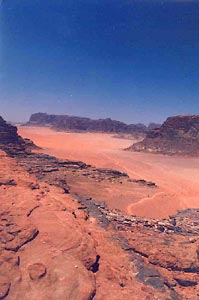
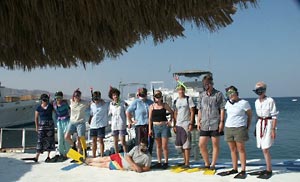
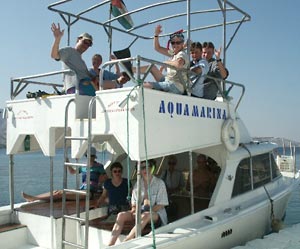
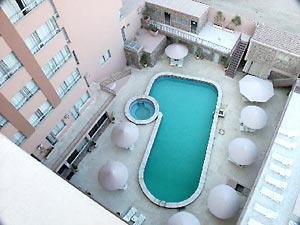
That's the way things were at Tall al-`Umayri this past week. But things were different in Aqaba where we spent a long, mid-season, take-a-break, get-me-outa-here-and-leave-me-there-due-to-cabin-fever weekend. As far as we are concerned, no sane person goes outdoors in Aqaba between the hours of 9 AM and 9 PM when the temperatures soar to 105 and the relative humidity is not particularly low. However, mad dogs and archaeologists go out in the noonday sun (with apologies to Noel Coward) and at least some of us were no exception. Die-hard shoppers made use of the nearby shops to look for souvenirs, others hiked the three blocks to the beach, some took a boat to go snorkeling among the interesting coral reefs lining to shores near the border with Saudi Arabia. Still others left for trip to the Wadi Rum in 4-wheel drive vehicles that bounced and ricocheted off sandy ruts as they took off across country in this marvelous place. The vehicles stopped now and then for various types of excursions and, of course, we learned much about Lawrence of Arabia, whose favorite place this was. But most of all, the weekend in Aqaba was R&R. We enjoyed the air-conditioned rooms and the nice buffet meals. We all (speaking of course not only for just the two of us) came back ready to jump into the dirt again.
This week, archaeology takes precedence. The momentum of our work is bearing fruit with interesting finds almost everywhere. First to Field B (Kent Bramlett and Doug Clark) where Wendell Bowes and James Hanson have finally reached the bottom of their huge garbage pit with the thousands of bones. In spite of the 5 seals they have found to go along with the bones and pottery from around 1200 BC, they are happy to have found an earth layer with solid Late Bronze Age pottery from around 1300 BC. We are tempted to congratulate them, but we must remember that they had the luxury of working in the shade until about 11 AM each day!
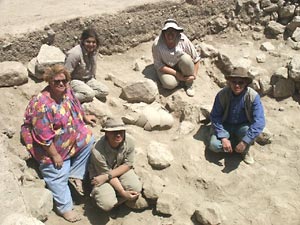 Each of the other three squares in Field B also have begun producing interesting finds. Howard Munson and Carmen Clark continue to delineate one of the most finely constructed walls at the site as it runs against the perimeter wall. They've found a second course and have established that it may be related to our wonderfully preserved Late Bronze Age building from around 1300 BC. Janelle Worthington, Michal Kurzyk, Nicole Murphy, and newcomer Christy Robinson were rewarded for several weeks of slogging through soft earth and rock tumble with a store jar dramatically smashed by a boulder that fell on top of it. The store jar, and a nice seal found nearby, date to the late Iron II period (about 550 BC). In one of the corners of the Square they have discovered the nicely preserved door leading into another room of the LB building. Ever since last year we had been hoping that this square would produce more rooms in this building!
Each of the other three squares in Field B also have begun producing interesting finds. Howard Munson and Carmen Clark continue to delineate one of the most finely constructed walls at the site as it runs against the perimeter wall. They've found a second course and have established that it may be related to our wonderfully preserved Late Bronze Age building from around 1300 BC. Janelle Worthington, Michal Kurzyk, Nicole Murphy, and newcomer Christy Robinson were rewarded for several weeks of slogging through soft earth and rock tumble with a store jar dramatically smashed by a boulder that fell on top of it. The store jar, and a nice seal found nearby, date to the late Iron II period (about 550 BC). In one of the corners of the Square they have discovered the nicely preserved door leading into another room of the LB building. Ever since last year we had been hoping that this square would produce more rooms in this building!
In the next square John Raab, Pawel Surowka and Candace Jorgensen had the fun of removing two walls of a house from the middle of the sixth century BC. They used the sledge hammer to bash up the largest stones (it is very gratifying to work out one's frustrations with such activity). While cleaning up the pieces and exploring some of the earth layers beneath, they came upon another large store jar sunk into the earth up to its rim. It was probably used along with the house they had just removed. They will have the fun of working on its removal next week.
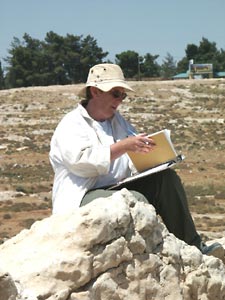 Field H (Julie Cormack) has also lived up to its expectations, producing other finds related to the religious nature of the large expanse of cobbled and plastered surfaces there. Two teams (Dean Holloway and Denise Herr, and Dick Dorsett, Jonathan Francisco and Caroline Riegel) removed two layers of plaster surfaces and are now coming down on the primary surface of the structure. Actually, it was probably an open space or courtyard with wooden side structures, judging by all the ash lying on the surface along the northern side of the courtyard. Last year this surface produced the shrine model we have mentioned in previous reports. Two weeks ago we found traces of a second shrine model near the western edge of the courtyard. This week many more fragments from yet a third model surfaced in the eastern part of the area.
Field H (Julie Cormack) has also lived up to its expectations, producing other finds related to the religious nature of the large expanse of cobbled and plastered surfaces there. Two teams (Dean Holloway and Denise Herr, and Dick Dorsett, Jonathan Francisco and Caroline Riegel) removed two layers of plaster surfaces and are now coming down on the primary surface of the structure. Actually, it was probably an open space or courtyard with wooden side structures, judging by all the ash lying on the surface along the northern side of the courtyard. Last year this surface produced the shrine model we have mentioned in previous reports. Two weeks ago we found traces of a second shrine model near the western edge of the courtyard. This week many more fragments from yet a third model surfaced in the eastern part of the area.
Meanwhile, kudos to Don Mook and Marcin Czarnowicz who have proved last year's field supervisor, David Berge, correct. Actually, Dave had a habit of being correct. But some of us doubted his conclusion that a massive wall near the edge of the site was really Iron Age II (around 550 BC) and not Iron I (around 1200 BC). The careful excavations of Don and Marcin have proved that the wall is indeed Iron II! That means Field H will have to move farther west next season to catch earlier remains.
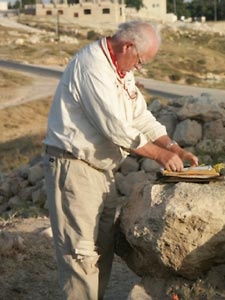 While we're on Don Mook, we need to inform the world of a new English word based on the style of archaeology for which Don has become a minor celebrity on our dig: mook (vb., trans., to select carefully certain pottery sherds and to discard others, thereby reducing the number of sherds that must be washed); derivatives: mooked (past participle [as in, "this pail has been mooked,"], used to describe pails of pottery to which mookian principles have been applied); mooktate (vb., trans., to alter the mooking process as the dig season progresses so that it will appear as if it were natural selection); mooktation (noun, the state of mooktating); mookification (noun, the tendency for others to adopt mooktation as the season progresses because they also wish to reduce the number of potsherds they must wash); mooky (adj., a pail of pottery that looks as if mookian principles have been applied-often muttered disapprovingly by the ceramic specialist at reading time).
While we're on Don Mook, we need to inform the world of a new English word based on the style of archaeology for which Don has become a minor celebrity on our dig: mook (vb., trans., to select carefully certain pottery sherds and to discard others, thereby reducing the number of sherds that must be washed); derivatives: mooked (past participle [as in, "this pail has been mooked,"], used to describe pails of pottery to which mookian principles have been applied); mooktate (vb., trans., to alter the mooking process as the dig season progresses so that it will appear as if it were natural selection); mooktation (noun, the state of mooktating); mookification (noun, the tendency for others to adopt mooktation as the season progresses because they also wish to reduce the number of potsherds they must wash); mooky (adj., a pail of pottery that looks as if mookian principles have been applied-often muttered disapprovingly by the ceramic specialist at reading time).
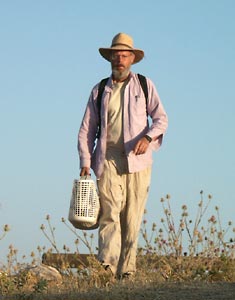 In Field L (David Hopkins), the limits, both vertically and horizontally, of the Hellenistic farmstead are becoming clearer and clearer. Kate Dorsett and Carolyn Waldron found the floor of a long room that held several objects, such as a hand-made juglet and a very small Hellenistic coin about a quarter of an inch in diameter. This completes their Mutt and Jeff set with the much larger coin found a couple of weeks ago (about 1.75 inches in diameter). On Friday they also found the tops of several Iron Age walls beneath the Hellenistic ones.
In Field L (David Hopkins), the limits, both vertically and horizontally, of the Hellenistic farmstead are becoming clearer and clearer. Kate Dorsett and Carolyn Waldron found the floor of a long room that held several objects, such as a hand-made juglet and a very small Hellenistic coin about a quarter of an inch in diameter. This completes their Mutt and Jeff set with the much larger coin found a couple of weeks ago (about 1.75 inches in diameter). On Friday they also found the tops of several Iron Age walls beneath the Hellenistic ones.
Frank Zollman and Audrey Shaffer took up a bumpy plaster surface and are proving that it was a Hellenistic surface instead of an Iron Age surface as we had thought from a small fragment in a neighboring square. Newcomer Audrey, who has dug for over 20 seasons at sites from the Roman and Byzantine periods (much later than ours-during the first millennium AD), was heard to exclaim with pleasure when, in the space of just a few minutes, she found two or three objects, all basalt grinder fragments. It's nice to know someone appreciates them.
Mary Boyd and Kathleen Geraty have accomplished one of the primary goals of the season in Field L. They have isolated and clarified the transition from the upper Hellenistic walls (ca. 150 BC) to the lower Iron II walls (ca. 550 BC). This may sound like it is easy (one wall built on top of another should be clear), but the Hellenistic builders liked to build their structures immediately on top of the earlier ones and there was often no change in masonry style. For me, this is one of the most satisfying discoveries of the season.
 We are now moving toward the final week. We have to make sure everything is ready to leave for the intervening two years. We want to minimize exposure to erosion and the destructive activities of goats. After a week of discoveries such as we have just had, no one wants to put down their pick and trowel. It's as if we are just beginning.
We are now moving toward the final week. We have to make sure everything is ready to leave for the intervening two years. We want to minimize exposure to erosion and the destructive activities of goats. After a week of discoveries such as we have just had, no one wants to put down their pick and trowel. It's as if we are just beginning.